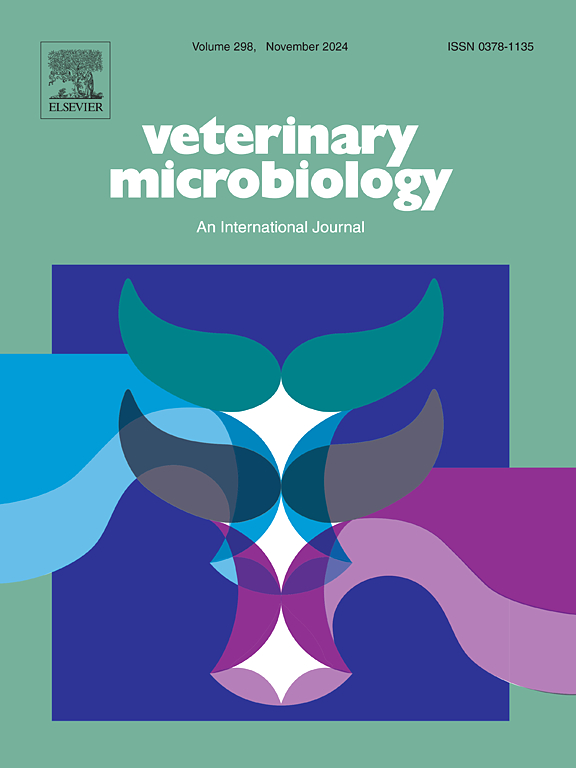头花苷通过MDA5/NF-κB/NLRP3信号通路减轻nibv诱导的焦亡
IF 2.4
2区 农林科学
Q3 MICROBIOLOGY
引用次数: 0
摘要
本研究阐明了cepharanthine (CEP)通过调节MDA5/NF-κB/NLRP3信号通路减轻nibv诱导的肾小管上皮细胞焦性死亡的机制。从1日龄海兰褐鸡中分离原代肾小管上皮细胞(RTECs),并将其分为4组。C+CEP组和N + CEP组接受0.5 μM CEP, NIBV组和N + CEP组接受1 MOI的NIBV SX9菌株CEP。研究表明,CEP显著降低NIBV感染后的NIBV载量(P <; 0.05),降低MDA5/NF-κB/NLRP3信号组分MDA5、ISP-1、TRAF6、TAK1、NF-κB、IKKα、IKKβ、NLRP3、caspase-1、IL-1β和IL-18 mRNA和蛋白水平(P <; 0.05或P <; 0.01)。此外,CEP显著降低细胞焦亡(P <; 0.001)和乳酸脱氢酶(LDH)活性(P <; 0.01)。流式细胞术和荧光检测证实了这些发现,显示在cep处理的细胞中,nibv感染后的焦亡显著减少(P <; 0.01)。激光共聚焦显微镜显示,CEP治疗后nlrp3相关的红色荧光灶明显减少。这些结果表明,CEP可通过调节MDA5/NF-κB/NLRP3信号通路,减轻nibv诱导的RTECs焦亡。本文章由计算机程序翻译,如有差异,请以英文原文为准。
Cepharanthine mitigates NIBV-induced pyroptosis via the MDA5/NF-κB/NLRP3 signaling pathway
This study elucidates the mechanism through which cepharanthine (CEP) mitigates NIBV-induced pyrodeath in renal tubular epithelial cells by modulating the MDA5/NF-κB/NLRP3 signaling pathway. Primary renal tubular epithelial cells (RTECs) were isolated from one-day-old Hy-Line Brown chicks and subsequently assigned to four groups. The C+CEP and N + CEP groups received 0.5 μM CEP, while the NIBV and N + CEP groups were exposed to 1 MOI of the SX9 strain of NIBV. The study shows that CEP significantly reduces NIBV load (P < 0.05) and decreases the mRNA and protein levels of MDA5/NF-κB/NLRP3 signaling components, such as MDA5, ISP-1, TRAF6, TAK1, NF-κB, IKKα, IKKβ, NLRP3, caspase-1, IL-1β, and IL-18, upon NIBV infection (P < 0.05 or P < 0.01). Moreover, CEP markedly reduced cellular pyroptosis (P < 0.001) and lactate dehydrogenase (LDH) activity (P < 0.01). Flow cytometry and fluorescence-based assays corroborated these findings, revealing a substantial diminution in pyroptosis post-NIBV infection in CEP-treated cells (P < 0.01). Laser confocal microscopy revealed a clear decrease in NLRP3-associated red fluorescence foci after CEP treatment. These results highlight that CEP could mitigate NIBV-induced pyroptosis in RTECs by modulating the MDA5/NF-κB/NLRP3 signaling pathway.
求助全文
通过发布文献求助,成功后即可免费获取论文全文。
去求助
来源期刊

Veterinary microbiology
农林科学-兽医学
CiteScore
5.90
自引率
6.10%
发文量
221
审稿时长
52 days
期刊介绍:
Veterinary Microbiology is concerned with microbial (bacterial, fungal, viral) diseases of domesticated vertebrate animals (livestock, companion animals, fur-bearing animals, game, poultry, fish) that supply food, other useful products or companionship. In addition, Microbial diseases of wild animals living in captivity, or as members of the feral fauna will also be considered if the infections are of interest because of their interrelation with humans (zoonoses) and/or domestic animals. Studies of antimicrobial resistance are also included, provided that the results represent a substantial advance in knowledge. Authors are strongly encouraged to read - prior to submission - the Editorials (''Scope or cope'' and ''Scope or cope II'') published previously in the journal. The Editors reserve the right to suggest submission to another journal for those papers which they feel would be more appropriate for consideration by that journal.
Original research papers of high quality and novelty on aspects of control, host response, molecular biology, pathogenesis, prevention, and treatment of microbial diseases of animals are published. Papers dealing primarily with immunology, epidemiology, molecular biology and antiviral or microbial agents will only be considered if they demonstrate a clear impact on a disease. Papers focusing solely on diagnostic techniques (such as another PCR protocol or ELISA) will not be published - focus should be on a microorganism and not on a particular technique. Papers only reporting microbial sequences, transcriptomics data, or proteomics data will not be considered unless the results represent a substantial advance in knowledge.
Drug trial papers will be considered if they have general application or significance. Papers on the identification of microorganisms will also be considered, but detailed taxonomic studies do not fall within the scope of the journal. Case reports will not be published, unless they have general application or contain novel aspects. Papers of geographically limited interest, which repeat what had been established elsewhere will not be considered. The readership of the journal is global.
 求助内容:
求助内容: 应助结果提醒方式:
应助结果提醒方式:


